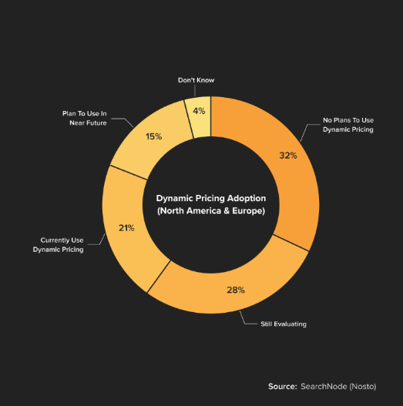Dynamic Price Optimization Explained
Dynamic price optimization, powered by cutting-edge software solutions, empowers OEMs to pinpoint the optimal price for their entire spare parts portfolio. This approach is tailored to align with the companies’ distinct business objectives, whether it's boosting revenue, increasing sales volume, or maximizing profit margins.

source: https://www.vaimo.com/blog/dynamic-pricing-in-ecommerce-how-it-works/
By harnessing sophisticated algorithms and robust data analysis, dynamic price optimization ensures a nuanced balance across a spectrum of desired outcomes. From maximizing sales to minimizing costs and everything in between, this strategy adapts to evolving market dynamics, customer preferences, and competitive landscapes. Unlike static pricing models, dynamic price optimization offers continuous refinement, allowing OEMs to make informed pricing decisions that drive sustainable growth and profitability.
What Are the Essential Components of Dynamic Price Optimization?
Dynamic price optimization entails harnessing advanced analytics, predictive modeling, and exhaustive data analysis to drive strategic pricing decisions. Its pivotal features include:
Understanding dynamic pricing and its benefits is essential for Original Equipment Manufacturers (OEMs) operating in the spare parts market. Here's why dynamic pricing can significantly benefit your business:
Cutting-Edge Analytics and Predictive Modeling:
Dynamic price optimization harnesses sophisticated analytics and predictive modeling to unearth crucial insights. These methodologies analyze extensive historical data, customer behavior trends, market dynamics, and external variables such as weather conditions to generate precise forecasts. By pinpointing price elasticities, demand fluctuations, and optimal pricing ranges, organizations can make decisive pricing choices that amplify profitability.
Precise Segmentation and Personalization:
A cornerstone of dynamic price optimization is its capability to segment customers into distinct cohorts based on their preferences, purchasing habits, and price responsiveness. By customizing pricing strategies for these segments, organizations can offer tailored deals, incentives, and discounts, fostering customer allegiance and propelling revenue expansion. Moreover, dynamic price optimization facilitates targeted price modifications for specific segments, demographic groups, or even individual customers.
At MARKT-PILOT, we focus on providing dynamic price optimization through our innovative and intelligent pricing software solutions, PRICERADAR and PRICEGUIDE. We have a wealth of experience and expertise in dynamic price optimization and recommendations, helping our customers employ this methodology for their spare parts pricing.

How Does Dynamic Price Optimization Work?
Dynamic price optimization operates by leveraging both internal and external data, forming a key component of its strategy.
Internally, various factors come into play:
-
Product Attributes: These encompass essential details like cost, base price, and margin ceiling, crucial for dynamic price optimization. Attributes such as brand or stock level are categorized to facilitate efficient data handling.
-
Transactional Data: This includes comprehensive records of transactions, price histories, conversions, and units sold, along with buyer details and sourcing costs. Machine learning algorithms heavily rely on diverse transactional data for their calculations.
-
Inventory Levels: Keeping track of inventory levels is key to ensuring smooth dynamic pricing operations. Understanding supply levels enables dynamic pricing software to calculate prices effectively.
Externally, certain key data points are necessary:
-
Competitor Data: Accessible information about competitors, including list prices, shipping costs, and product reviews, is analyzed by dynamic optimization software. Most competitor data is publicly available and aids in informed pricing decisions.
-
Weekdays: Consumer demand fluctuates depending on the day of the week, influencing sales patterns. Recognizing these correlations provides valuable insights for dynamic pricing strategies.
-
Regional Trends: Identifying regional variations in consumer behavior allows companies to tailor pricing strategies to specific geographic areas. Analyzing regional trends helps in fine-tuning dynamic pricing approaches.
It can be hard to manage these large amounts of data, especially when it comes to understanding how to best optimize your spare parts prices. This is where our PRICEGUIDE solution comes in. The software offers automated, customized, and validated price suggestions, making adaptations to the dynamic market possible.
A Fundamental Example of a Dynamic Pricing Model
In dynamic price optimization, understanding market trends becomes paramount for effective decision-making.
For instance, within the aviation sector, GE strategically employs dynamic pricing to adjust the pricing of its jet engines based on market demand fluctuations. During periods of heightened demand, such as when airlines are expanding their fleets, GE may implement premium pricing strategies for its engines. Conversely, during downturns or periods of low demand, GE may adopt a more flexible pricing approach, possibly reducing prices to attract more customers and maintain competitiveness.
Dynamic price optimization stands as a top strategy tailored for OEMs, providing an avenue for perpetual refinement and seamless adaptation to market dynamics. Through harnessing the power of advanced analytics and personalized segmentation, businesses can meticulously craft pricing strategies that are both informed and agile, thereby steering towards enhanced profitability. Embracing dynamic price optimization empowers businesses to fine-tune pricing strategies effectively, fostering sustainable growth within fiercely competitive markets.
